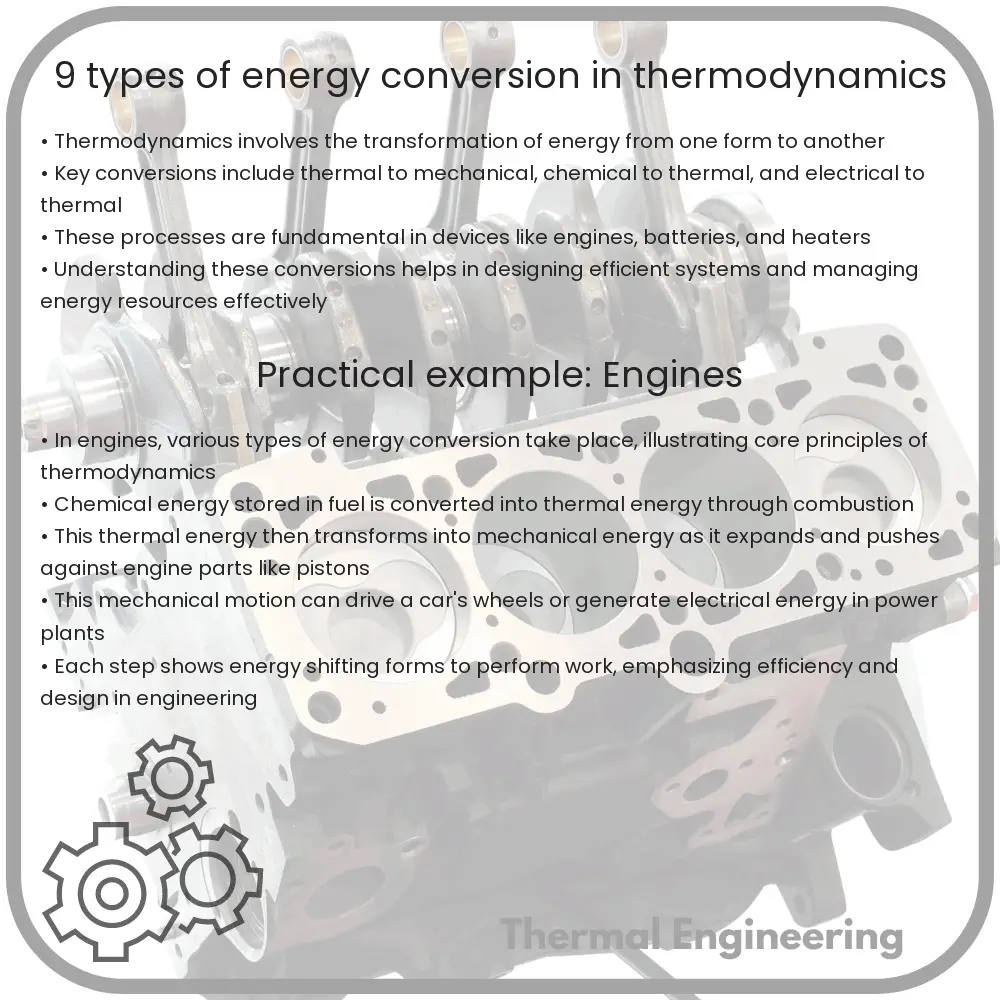Learn about energy conversion in thermodynamics, highlighting nine common types, including chemical, electrical, and mechanical transitions.

Understanding Energy Conversion in Thermodynamics
Thermodynamics, a branch of physics involved with heat, work, temperature, and energy, plays a critical role in understanding how different forms of energy are converted from one type to another. Energy conversion is central to all thermodynamic processes and crucial for various engineering applications. Let’s explore nine common types of energy conversions that illustrate the fundamental principles of thermodynamics.
1. Chemical to Thermal Energy
When chemical energy is released from a substance, it often turns into thermal energy. This transformation is evident in processes like combustion, where burning fuels like coal, oil, or gas releases heat.
2. Electrical to Mechanical Energy
Electric motors convert electrical energy into mechanical energy. This process is pervasive in household appliances, manufacturing machinery, and electric vehicles, where electric energy supplied by batteries or power lines is transformed into motion.
3. Thermal to Electrical Energy
In thermoelectric generators, a temperature difference across certain materials can generate an electric voltage, thus converting thermal energy directly into electrical energy. This effect is also utilized in technologies such as radioisotope thermoelectric generators in spacecraft.
4. Radiant to Chemical Energy
Photosynthesis is a natural process where light energy (radiant energy) from the sun is converted into chemical energy within the cells of plants. This energy is stored in the form of glucose and other organic molecules.
5. Mechanical to Electrical Energy
Generators convert mechanical energy into electrical energy. This process is critical in power plants, where mechanical energy provided by steam turbines, water turbines, or wind turbines is transformed into electrical energy distributed across power grids.
6. Electrical to Thermal Energy
Devices like electric heaters and resistors commonly convert electrical energy into thermal energy. When electric current flows through a resistive material, it generates heat through the resistance encountered by the electrons in motion.
7. Nuclear to Thermal Energy
Nuclear reactors perform the conversion of nuclear energy from the fission of atoms into thermal energy. The heat generated is then used to produce steam that drives turbines to generate electricity.
8. Mechanical to Hydraulic Energy
In hydraulic systems, mechanical energy is used to move and compress fluids under pressure. This conversion is fundamental in machines like hydraulic presses, excavators, and some types of energy storage systems.
9. Thermal to Mechanical Energy
Steam engines convert thermal energy into mechanical energy. The high-pressure steam produced from boiling water drives pistons or turbines, converting the high temperature and pressure into mechanical motion.
Each of these conversions involves the transformation of energy from one form to another, guided by the laws of thermodynamics. Ultimately, the study of these energy transformations not only deepens our understanding of physical phenomena but also enhances our ability to engineer systems for more efficient energy use in industrial, domestic, and environmental applications.